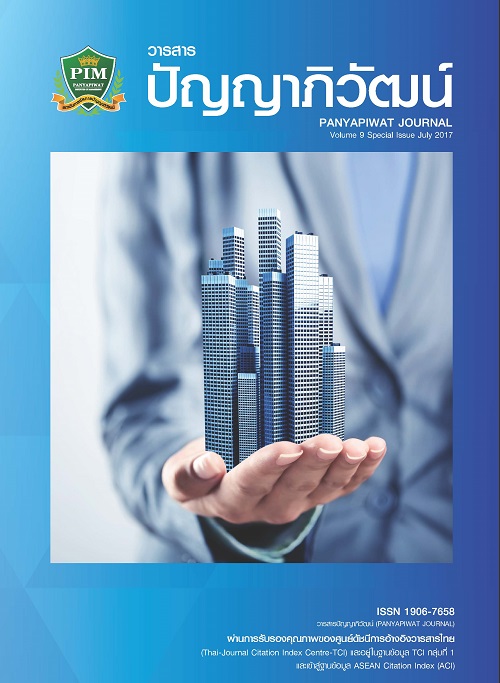กลยุทธ์การตลาดสีเขียวและคุณค่าร่วม: ธุรกิจนำเที่ยวไทยในตลาดเออีซี
Main Article Content
Abstract
การศึกษาครั้งนี้ มีวัตถุประสงค์การวิจัยเพื่อศึกษา 1) เพื่อศึกษาความสัมพันธ์เชิงสาเหตุระหว่างกลยุทธ์การตลาดสีเขียวและการสร้างคุณค่าร่วมในธุรกิจนำเที่ยวของไทยในตลาดเออีซี และ 2) เพื่อพัฒนารูปแบบกลยุทธ์การตลาดสีเขียวสัมพันธ์กับการสร้างคุณค่าร่วมในธุรกิจนำเที่ยวของไทยในตลาดเออีซี
เครื่องมือที่ใช้ในการวิจัยคือ แบบสอบถาม (Questionnaire) ซึ่งเก็บรวบรวมข้อมูลจากกลุ่มตัวอย่างธุรกิจนำเที่ยวจำนวนทั้งสิ้น 666 แห่ง การวิเคราะห์ข้อมูลใช้ค่าสถิติ ได้แก่ การแจกแจงความถี่ ค่าร้อยละ ค่าเฉลี่ยเลขคณิต ค่าส่วนเบี่ยงเบนมาตรฐาน ค่าความเบ้ ค่าความโด่ง และเทคนิคการวิเคราะห์โมเดลสมการโครงสร้าง
กลยุทธ์การตลาดสีเขียวและการสร้างคุณค่าร่วมในธุรกิจนำเที่ยวของไทยในตลาดเออีซีที่พัฒนาขึ้นมีความกลมกลืนกับข้อมูลเชิงประจักษ์ และมีความสามารถในการพยากรณ์ระดับดีและเป็นที่ยอมรับ ผ่านเกณฑ์ร้อยละ 40 ขึ้นไป (x2/df = 2.863, GFI = 0.972, CFI = 0.978, TLI = 0.956, PGFI = 0.640, RMR = 0.040, RMSEA = 0.048) ตลอดจนรูปแบบที่พัฒนาขึ้นถูกต้อง มีความสามารถในการพยากรณ์ (ร้อยละ 86.7) ความสัมพันธ์เชิงสาเหตุพบว่า กลยุทธ์การตลาดสีเขียวเกี่ยวกับหัวใจสีเขียว รูปแบบการเดินทางสีเขียว แหล่งท่องเที่ยวสีเขียว ชุมชนสีเขียว กิจกรรมสีเขียว การบริการสีเขียว ความรับผิดชอบต่อสังคมและสิ่งแวดล้อม รวมถึงกลยุทธ์การสร้างคุณค่าร่วมต่างมีความสัมพันธ์เชิงสาเหตุต่อธุรกิจนำเที่ยวของไทยในตลาดเออีซีที่ระดับนัยสำคัญทางสถิติ 0.05
This research is aimed to (1) study green marketing strategy and shared value for Thailand’s tourist operators’ business in AEC market. and (2) develop the green marketing strategy and shared value for Thailand’s tourist operators’ business in AEC market.
The statistical tool is questionnaire. All data collected from tourist business sampling of 666 representives. The data analysis of frequencies distribution, percentage, arithmetic mean, standard deviation, skewness, kurtosis including structural equation model analysis.
The green marketing strategy and shared value and Thailand’s tourist guide business for AEC market has developed in accordance with the impirical data and can be predictable at good and acceptable level passing the measurement standard of above 40 percentage. (x2/df = 2.863, GFI = 0.972, CFI = 0.978, TLI = 0.956, PGFI = 0.640, RMR = 0.040, RMSEA = 0.048), though the model development was acculate and could be well forecasted at the good and acceptable levels (86.7%). The causal relationship found that green marketing strategy , green tourism model, green destination, green community, green activity, green service, social responsibility and environment including shared value creation has causal relationship on Thailand’s tourist business in AEC market at 0.05 statistical significance.
Article Details
I and co-author(s) certify that articles of this proposal had not yet been published and is not in the process of publication in journals or other published sources. I and co-author accept the rules of the manuscript consideration. Both agree that the editors have the right to consider and make recommendations to the appropriate source. With this rights offering articles that have been published to Panyapiwat Institute of Management. If there is a claim of copyright infringement on the part of the text or graphics that appear in the article. I and co-author(s) agree on sole responsibility.
References
Amonchai, S. (2009). Green Product for Sustainable Environment. Science Service Section Journal, 57(179), 29-36. [in Thai]
Beugen, A. (2005). Sustainability of Dutch tour operators. Doctoral dissertation, Doctoral Thesis, Tiburg University.
BrandAge. (2011). Shared Value Creation to New Capitalism with CSV. Brandage Essential,4, 67-74. [in Thai]
Cochran, W. G. (1977). Sampling Techniques (3rd ed.).New York: John Wiley & Sons.
Enderle, G. (2004). Global competition and corporate responsibilities of small and medium–sized Enterprises.Business Ethics: A European Review, 13(1), 50-53.
Grant, J. (2007). The Green Marketing Manifesto. England: John Wiley & Sons.
Hoyer, K. G. (2000). Sustainable Tourism or Sustainable mobility? Journal of Sustainable Tourism, 8(2), 147-160.
Hunt, N. & Dorfman, B. (2009). How Green is my Wallet? Organic Food Growth Slows. Retrieved September 12, 2014, from http://reuters.com
Joreskog, K. G. & Sorbom, D. (1993). Lisrel 8: Structural Equation Modeling with the Simplis command language. Chicago: Software International.
Kline, P. (1994). An easy guide to factor analysis. London & New York: Routledge.
Kuharattanachai, C. (2003). Introduction to Statistics. Bangkok: Applied Statistics Section, Mahanakorn University of Technology. [in Thai]
Manager Online. (2013). Thailand Tourism Sets a Show “7 Greens Fair” Support New Modern Marketing. Retrieved May 16, 2014, from www.manager.co.th/iBizChannel/ViewNews.aspx?NewsID=9570000051306 [in Thai]
Muthen, B. Q. (2006). Latent variables modeling in heterogeneous populations. Psychometrica, 54(4), 557-586.
Nkonoki, S. (2012). Challenges of Tour Operators. Tanzania: University of Applied Sciences.
Patrick, D. (2008). 6 Green Marketing Strategies for Successful Sustainable Brands. Retrieved August 8, 2014, from www.greenbusinessinnovators.com/6-green-marking-strategies-for-Successful-sustainable-brands
Pengmark, J. (2016, May 18). Economy: Tourism Takes Increased Income Strategy of spotting “Sport Tourism” In The World Arena. Dailynews, p. 6. [in Thai]
Porter, M. E. & Kramer, M. R. (2011). Creating shared value. Harvard Business Review, 89(1/2), 62-77.Porter, M. E. (2011). The role of business in society: Creating shared value. Retrieved July 24, 2014, from www.isc.hbs.edu/pdf/2011-1113_Babson_CSV.pdf
Prasitrathasin, S. (2008). The Analysis Techniques of Variable for Sciences Research and behavioral Science (Handbook of Researcher and Guidelines): Principles Method and Application(6th ed.). Bangkok: Samlada. [in Thai]
Saris, W. E. & Strenkhorst. L. H. (1984). Causal modeling non experimental research: An Introduction to the lisrel approach. Dissertation Abstract International,47(7), 2261-A.
Soonthornchareonnon, V. (2013). “CSV” Sustainable Support on Brand with economic and Society. Retrieved May 8, 2014, from www.amexteam.com/knowledge-detail.php?ref=do:read/id:59 [in Thai]
Thomson, S. K. (1992). Sampling. New York: John Wiley & Sons.
Titley, B. (2008). Competitive advantages and Green business. London: Ernst & Young.
TOI. (2003). Tour operators take action towards sustainability.Retrieved August 16, 2014, from http://www.uneptieorg/pc/tousion/doeuments/toicases/TOI-wtm(2003)–ressreleasofinal.pdf
Tour Guide Registrar Office. (2014). Completion of Statistical Registration of Entrepreneurs. Retrieved May 23, 2014, from http://122.155.9.59:8081/stm4/NewReport/report509.jsp [in Thai]
Viratchai, N. (2009). LISREL: Statistical Analysis for Social Science and Behavior. Bangkok: Chulalongkorn Printing House. [in Thai]
West, S. G., Finch, J. F. & Curan, P. J. (1995). Structural equation model with non-normal variable: Problem and remedies. Thousand Oaks: CA: SAGE.
Yodprudtikan, P. (2014). Strategic Business Along with Society. Retrieved November 8, 2014, from http://www.csvforum.com [in Thai]


